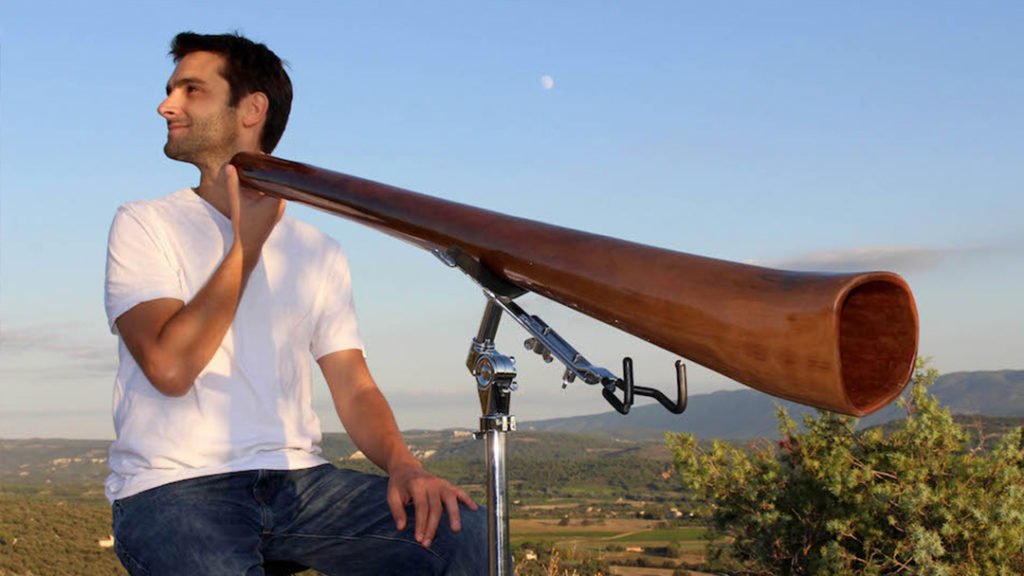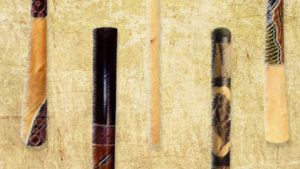Did you know that in Kyūdō, the Japanese archery, the archer works his posture for months, before unleashing his first arrow? Any activity that uses the body relies on a correct posture. Didgeridoo is no exception to this rule. By following these five tips, you will be surprised to see your playing change under the influence of the way you sit!
1. The height of your seat
Assuming that you are sitting down, here is the ideal position: have your feet on the floor, forming with your knees a slightly wider angle than a right angle. In other words your pelvis is slightly higher than your knees. This will provide you helpful fulcrums on your two legs. Personally, I use a drummer’s stool. This objet has the advantage of being comfortable (so, why not ! :-)) and easily adjustable. However, you can also use a simple adjustable height stool.
2. The importance of your fulcrums
A good seat will naturally provide you with more stable fulcrums. Both of your feet anchored to the ground will form a tripod with your buttock and provide you with great stability! Initially, a beginner’s breathing comes from the top of his/her lungs (shoulder level). With time and practice, it gradually goes down to the stomach and reaches the buttocks. One can now understand the link between the seat and breathing! It’s simple: the more your breathing will be anchored in your body, the more your sound will be powerful and stable. In return, your breathing will need a stable base. Only one small detail is now needed to provide you with a perfect posture: a small forward tilting of your pelvis in order to deport the weight of your body on your legs.Do not move anymore, you are perfect!
3. Your back, the spine of your sound
Feet on the ground, well-established buttocks, and we now logically move on to the back. The back is your righteousness, it is your ability to maintain the sound. If your back is hunched, so will be your sound. Your diaphragm will be suffocating under the curve of your spine. It will have no freedom to move. Conclusion : your sound will be lacking power and strength. In other terms, you will be self-sabotaging yourself! However, a straight back will provoke a straight sound. The practice of Zazen (Japanese meditation) insists on the posture and righteousness of the back. So keep your back straight and open your chest by placing your shoulders backwards and notice the change on your sound. (Zazen posture image)
4. The height and the stability of your didgeridoo
Your body is now in position, all we need to do now is place your didgeridoo! The bell of your didgeridoo should be, at least, at pelvis level. However, to do well, it should at least reach the height of your diaphragm. Beware of the didgeridoo on the floor, it has two drawbacks: it develops more low tones, and if you are sitting on a chair, your neck will be “broken”. If you can, find a tripod on which you can place your instrument to provide it with stability. It will relieve your arms from the weight of the instrument and the bell of the didgeridoo, sitting in the air, will provide a clearer and more uniform sound.
5. Stay relaxed
Of course, all the comments above will be much more effective if you take the time to relax. All didgeridoo players know it: playing relaxed changes everything.Techniques come more easily when one is relaxed. The breathing is deeper, the diaphragm is more flexible: everything is more natural. Take time to relax your face, your throat, your shoulders, your arms, your stomach. You must find the balance between a dynamic posture and a relaxed body. You will improve fluency and lightness, your music will be more gentle and yet powerful … An iron fist in a velvet glove. 🙂
Conclusion: Sitting is far from being trivial
By looking at the seat, one can guess what an instrumentalist’s sound is like. When I give my courses, I very much study my students’ postures. It reveals alot about the musician’s personality. Thus, i dispose of valuable information about the way one plays even before one blows. Look for yourself, it’s striking! Beyond the posture, the seat represents the sound you want to make, your place, what you have to say with your instrument. It is fully accepted, anchored here and now. Assume you music and what you have to say!
Share your sitting experience in a comment! 🙂
To go further (fr): check the Alexander Technique (Wikipedia)












